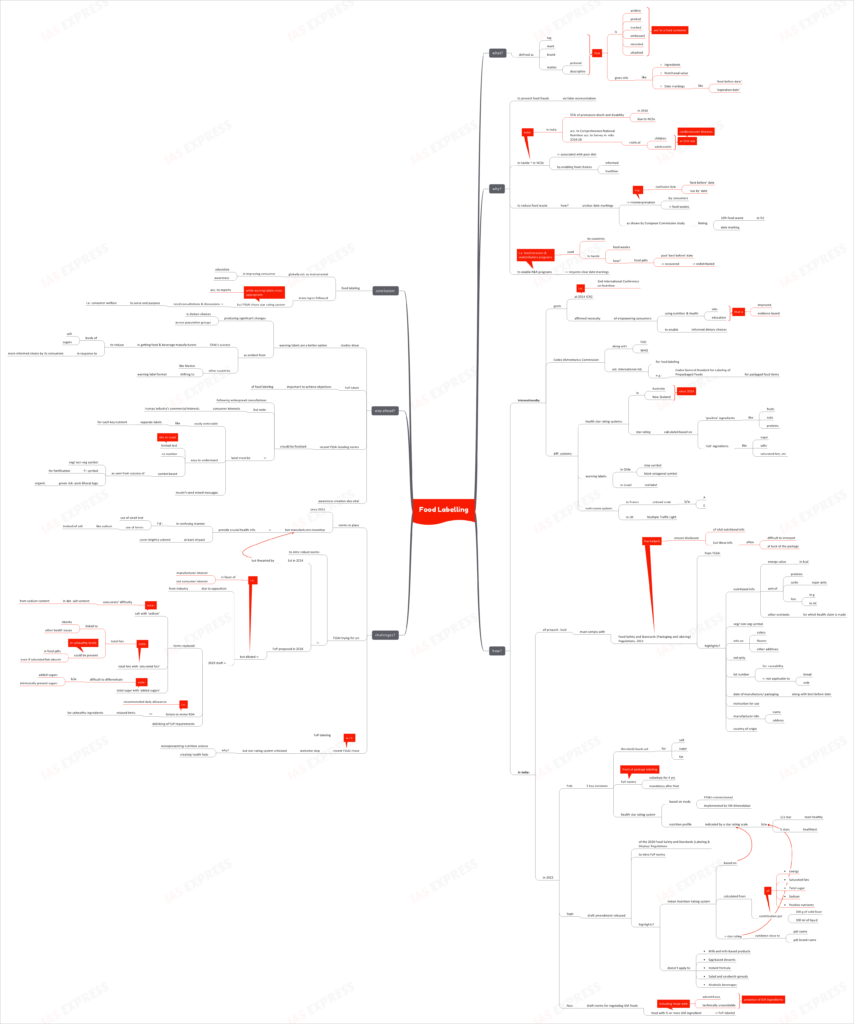Food Labelling- Need, Systems and Draft FSSAI Norms

From Current Affairs Notes for UPSC » Editorials & In-depths » This topic
IAS EXPRESS Vs UPSC Prelims 2024: 85+ questions reflected
India is witnessing a major shift in the types of diseases affecting its human resource. India is facing more of non-communicable, life-style related diseases than the historical communicable type of diseases. During this shift, a healthy diet is paramount to ensuring the health of the population. In this context, the need for a robust food labelling system comes into focus.

What is food labelling?
- Food label can be defined as a tag, mark, brand, pictorial or any other descriptive matter that is written, printed, marked, embossed, stencilled on or attached to a food container.
- This label contains several information, such as:
- Ingredients
- Nutritional value
- Date markings, like ‘best before date’ and ‘expiration date’
Why is it needed?
- A key objective of food labelling is to stop sellers from deceiving the consumer using false representations on their product containers.
- The world is facing a spike in the number of non-communicable diseases, often associated with poor diet. Food labels can help consumers make informed and healthier food choices.
- In India, for instance, 55% of premature death and disability in 2016 was due to non-communicable diseases.
- According to the Comprehensive National Nutrition Survey in India 2016-18, more than half of India’s children and adolescents are at risk of CVDs (cardio-vascular diseases).
- Date markings in the food labels could help reduce food waste.
- Sometimes, unclear date markings could lead to misinterpretation by the consumers, resulting in food wastage. Eg: consumers are often confused on how ‘best before’ date is different from ‘use by’ date.
- For instance, a study by the European Commission found a link between 10% of the food waste in EU and date marking.
- To tackle food wastage, several countries have launched food recovery and redistribution systems. These systems are highly reliant on date markings. For instance, food products that are past the ‘best before’ date (as opposed to ‘use by’ date) are recovered and redistributed. Hence, clear and valid date markings are vital.
What has been done till now?
Internationally:
- The governments, at the 2014 ICN2 (2nd International Conference on Nutrition) affirmed the necessity of empowering consumers using improved, evidence-based health and nutrition education and information, to enable informed dietary choices.
- The FAO and WHO works with the Codex Alimentarius Commission to establish international food labelling standards. The Codex General Standard for Labelling of Prepackaged Foods is a key instrument for informing consumers about packaged food items.
- Health star rating systems:
- Australia and New Zealand has been implementing a health-star rating system since 2014.
- In this system, a food product’s star rating is calculated based on its ‘positive’ ingredients (like fruits, nuts and proteins) and ‘risk’ ingredients (like sugars, sodium, saturated fats, etc.)
- Warning labels:
- Chile uses warning labels depicting a stop symbol or a black octagonal symbol to warn consumers about a product’s high salt, sugar or fat content.
- Similarly, Israel uses a red label to indicate such products.
- Nutri-Score system:
- France uses a colored scale, ranging from A to E to indicate the product’s nutritional value.
- The UK uses the Multiple Traffic Light for the same purpose.
In India:
- All prepackaged food products in India must comply with the Food Safety and Standards (Packaging and labelling) Regulations, 2011- a set of norms issued by the FSSAI (Food Safety and Standards Authority of India).
- Label must include nutritional information:
- Energy values (in kilocalories)
- Amount of
- Proteins
- Carbohydrates (specifying the sugar quantity)
- Fats (in grams/ ml)
- Amount of other nutrients (for which a health claim is made)
- It must include a symbol to indicate whether the product is vegetarian or non-vegetarian. This is a green/ red symbol depicting a square with a circle inside.
- Information on colors, flavours and other additives should be included.
- Net quantity
- Lot number, batch number or a code number should be included to enable traceability. This doesn’t apply to bread and milk.
- Date of manufacture/ packing, along with best before date
- Instruction for use
- Manufacturer information
- Country of origin (in case of imported product)
- Label must include nutritional information:
- While FSSAI had ensured that food manufacturers disclose such vital nutritional information over these years, such data often get placed on the back of the packaging. In many cases, consumers find it difficult to interpret the labels.
- Hence, in February 2022, three important decisions were taken regarding FoP (Front of Package) labelling:
- The threshold levels of sugar, salt and fat in food products beyond which it would be considered as ‘high’
- The FoP norms are to be voluntary for 4 years, after which it would become mandatory.
- Implementation of a health star rating system
- This system was designed based on an FSSAI-commissioned study, implemented by IIM-Ahmedabad.
- In this system, a product’s nutrition profile would be indicated by a star rating scale, ranging from half a star to 5 stars.
- In September, the FSSAI released a draft amendment of the 2020 Food Safety and Standards (Labelling & Display) Regulations, for introducing FoP labelling norms:
- The draft called for the implementation of the Indian Nutrition Rating (INR) system, based on the health star rating concept.
- The INR is calculated based on contribution/ 100 g of solid food (100 ml in case of liquids):
- Energy
- Saturated fats
- Total sugar
- Sodium
- Positive nutrients
- Based on the INR, the product is to be rated between half a star (least healthy) to 5 stars (healthiest) which is displayed in close proximity to the product’s name/ brand name on the front of the package.
- The norms won’t be covering certain products like:
- Milk and milk-based products
- Egg-based desserts
- Instant formula
- Salad and sandwich spreads
- Alcoholic beverages
- In November, FSSAI released the draft norms for regulating GM foods:
- Food products containing 1% or more of genetically modified ingredients are to carry FoP labels.
- The labelling norms would also apply to products with “adventitious or technically unavoidable presence of GM ingredients”.
What are the challenges?
- While India already has norms in place since 2011, food manufacturers have been quite inventive over the years. They provide such crucial health information in confusing language, often at the back of brightly colored packages so that the consumer either fails to notice it or doesn’t understand it. Eg: use of miniscule text, use of terms like ‘sodium’ instead of salt, etc.
- The FSSAI has been attempting to bring in an efficient food labelling system for many years now.
- It first attempted to bring in a robust labelling system in 2014. However, its efforts were thwarted by the packaged food makers.
- It proposed FoP labelling in 2018. However, this too remained a draft as industry opposed it, fearing that labelling the products with ‘red’ would represent ‘danger’.
- The 2018 draft was diluted in 2019 so that:
- Certain terms were replaced: salt with ‘sodium’, total fats with ‘saturated fats’ and total sugar with ‘added sugars’.
- Note that not many consumers understand the calculation of salt content based on sodium content.
- Many products may be high in total fats, without much saturated fats. While saturated fats are linked to heart diseases, total fats too can lead to obesity and other health complications.
- It is difficult to differentiate between added sugars and sugars that are intrinsically present in food products.
- Even while making such crucial changes, the draft failed to revise the RDA (recommended daily allowance) for sugar- relaxing the limits for such unhealthy ingredients.
- Eventually, the FoP labelling requirements were delinked from the draft norms. In short, the norms’ formulation has gone more in favour of the manufacturers’ interest, than the consumers.
- Certain terms were replaced: salt with ‘sodium’, total fats with ‘saturated fats’ and total sugar with ‘added sugars’.
- While FSSAI finally bringing in the draft FoP norms is a welcome move, the health star rating system is facing criticism:
- Such a system risks misrepresenting nutrition science. For instance, just because a product has fruit in it doesn’t mean that the added sugar will stop harming the consumer.
- There is also a fear that rating the products with stars would create a ‘health halo’. Consumers tend to think of stars as being related to quality, rather than healthiness of the ingredients.
What is the way ahead?
- Studies show that warning labels are a better option compared to all other formats of food labelling. This system has been shown to produce significant changes in dietary decisions across all population groups.
- This is evident from how Chile succeeded in getting its food and beverage manufacturers to reduce their sugar and salt levels in response to more informed choice by its consumers. Several countries, like Mexico are already shifting to the warning label format.
- FoP labelling plays a crucial role in achieving the objectives of food labelling. There is strong evidence to show that sugars, salts and fats are addictive- like nicotine in tobacco, and FoP labels have helped reduce tobacco consumption over the years.
- The recent FSSAI labelling norms must be finalized following widespread consultations. However, consumer interests trumps the industry’s commercial interests.
- The norms must introduce labels that are readily noticeable and easy to understand. They mustn’t send mixed messages.
- Labels with limited text and no numbers, like the ones used in Israel, could be considered. The option of separate labels for each key nutrient could also be considered to boost visibility.
- Symbol-based labelling is likely to find success in India, given the performance of the vegetarian symbol, +F logo (denoting fortification) and the green tick Jaivik Bharat logo (for organic products).
- In addition to proper formulation of norms, awareness generation is a key step. All the supply chain stakeholders and the consumers must be educated on food labelling norms.
Conclusion:
Food labelling is globally established as instrumental in improving consumer education and awareness. Among the numerous labelling systems implemented across the world, the recent FSSAI draft has put forth the star rating system. However, many experts consider the warning label system to be more appropriate. Stakeholder consultations and discussions should result in a labelling system that serves the end purpose: consumer welfare.
Practice Question for Mains:
Discuss the importance of food labelling. How is India labelling its packaged food products? What needs to be done? (250 words)
If you like this post, please share your feedback in the comments section below so that we will upload more posts like this.

